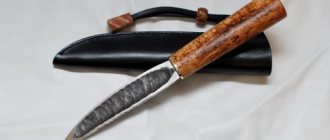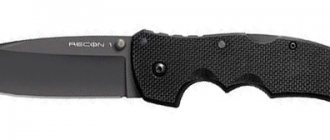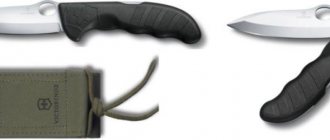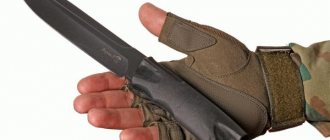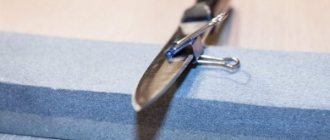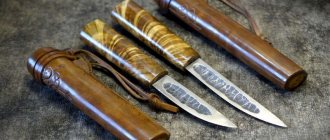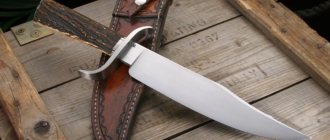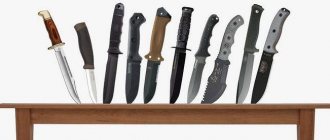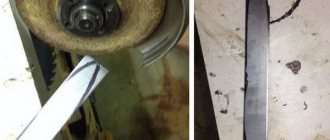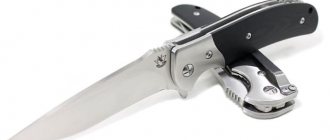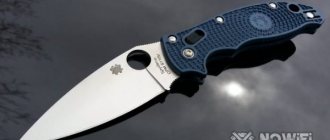The traditional ancient type of bladed weapon of the peoples inhabiting the mountainous country of Nepal has a unique name - Kukri (khukuri, khukuri). These are heavy, massive, durable, well-balanced knives that can be used in close combat, making paths and building huts. In everyday life, they can be called anything: cutlasses, machetes, knives and even short swords.
Nepalese kukri knife: main characteristics
A traditional Nepalese knife is made only from high-carbon types of steel, which are sharpened at a certain angle and are zone hardened. The blades are crescent-shaped, with sharpening that runs along their inner sides. In addition, the lower parts of the knives expand so that their centers of gravity are close to the tip. Such unusual shapes make it possible to apply minimal effort when delivering chopping blows.
At the base of the blades of Nepalese classic kukri knives there are special figured cuts called “cho”, and “lobes” or “dales” run along the butts. The presence of such elements is necessary in order to improve the rigidity and shock absorption of the blades. Historians also note their certain symbolic meanings. According to some versions, “dolyas” are the main attributes of the god Shiva and his other half, the goddess Kali.
Nepalese kukri knife
Having been a fan of knives in the past, over time my attitude towards knife topics has become more relaxed. The knife became for me more of a tool for solving its inherent problems and an element of equipment than an object of desire, as is usually the case among “knife-maniacs”. But the love for certain types of knives still remains. And one of these knives was the Nepalese kukri knife.
History of the Nepalese kukri knife
Kukri is a Nepalese Gurkha knife. Nepalese Gurkhas are famous for their fearlessness and high moral endurance. An elite group of Gurkhas has been in the service of the Queen of England since the 19th century, taking part in both world wars and local conflicts involving Great Britain. And if the katana is the symbol of the Japanese samurai, then the symbol of the Nepalese Gurkhas is the kukri, which is their combat knife. The skillful use of kukri and the high destructive properties of this type of knife helped the Gurkhas become famous during night raids, close combat and trench warfare.
Kukri, otherwise spelled khukri or khukuri (khukri or khukuri) - there is no consensus on this matter. But the most common one is kukri or khukri. I suggest sticking with the simplest option - kukri.
Kukri is a traditional Nepalese knife, the first mention of which dates back to the previous era. The samples preserved in museums date back to the 14th and 15th centuries. Thus, kukri is one of the ancient types of bladed weapons that have survived to this day practically unchanged. At the moment, kukri is included in the equipment of the military and police. The Nepalese knife is a curved blade, sharpened on the inside. Like any ancient weapon, the kukri has not only design features, but also symbolic ones.
1 — blade with zone hardening (for large kukri models)
2 - dol, is called “Sword of Shiva”. Serves to increase shock-absorbing properties when cutting and reduce the weight of the blade.
3 - kukri handle
4 - rings on the handle serve to better hold the knife and symbolize the levels of the universe
5 - Blade edge with variable sharpening angle, ensuring efficiency in chopping and cutting blows.
6 - “Tooth of Shiva” - or Cho, symbolizes the trident of the god of strength and destruction. It is not only symbolic, but also relieves tension in the metal during cutting. In the absence of Shiva’s tooth, it is in this place that the blade may chip when chopping. Also, a finger was pricked on this trident of war to stain the blade with blood (according to some sources). Instead of a trident, Cho is sometimes made in the form of the symbol of the goddess Kali, or the footprint of a sacred cow.
7 — The metal top of the handle allows you to more securely hold the kukri in your hand when chopping, closes the end of the shank in the handle and symbolizes the all-seeing eye of God.
Nepalese kukri manufacturing technology
To make a kukri blade in Nepal, they mainly use steel from old car springs. Thanks to zone hardening, the butt is soft, its hardness is only 35-45 HRC, and the hardness of the blade is 55-58 HRC. Zone hardening makes the blade insensitive to impact loads. The sharpening angle is minimum at the base and maximum in the middle of the blade.
All steel is inspected for chips and the best specimens are selected. As a rule, 4 people are involved in the production of one copy of kukri. Almost all operations are performed manually by craftsmen. The art of making kukri is passed down from generation to generation from a very young age.
The workpiece is heated red-hot in a coal furnace, after which the forging of the blade shape begins.
After forging the shape of the blade, Shiva's tooth is knocked out
The next step is for the master to pour water onto the blade of the hot blade for hardening. The manipulation is very delicate, since the water should only get on the blade. Next comes the formation of the blade shape and primary sharpening.
Knocking out the fullers and turning the shank
Shaping the handle and fitting onto the tang using epoxy resin from Lach wood.
Planing the wooden halves for the scabbard and dressing water buffalo leather for the scabbard.
Leather covering of wooden scabbard halves
Kukri are usually equipped with two small knives, which are also placed in a sheath. One is blunt, in the form of an abrasive - chakmak, intended for sharpening, and the second - card (karda) for small household work. This is somewhat reminiscent of the concept of three knives.
There are several varieties of kukri, differing in size, weight and angle of curvature of the butt, but they are all united by a common curved shape, which cannot be confused with other types of knives. Universal kukri models weigh 450-900 g with a length of 200 - 350 mm. The thickness of the butt above the convex middle part of the blade can reach 10 mm, the concave shape of the blade and the balancing shifted towards the tip allows for powerful slashing blows due to inertia, and not the strength of the fighter.
According to the classification, the kukri occupies a place between a large heavy knife and a light ax. The Kukri is ideal as a large survival knife. With such a knife you can build a shelter and clear a road in the thicket. It is more compact than a machete and more versatile. In Nepal, it is not only a combat knife, it is also used by ordinary peasants for household work, and even by women in the kitchen.
In addition to directly Nepalese kukri, there are models from various manufacturers on sale, ranging from Chinese ones, like Pirat and Viking Nordway, to famous brands like Cold Steel. All these models, as a rule, do not have Shiva's tooth.
Comments
+2 Pavel Ch 07/30/2013 08:56 “... there are models from various manufacturers. .. like Pirat and Viking Nordway, and... Cold Steel. All these models, as a rule, do not have a Shiva tooth...” They do not have a variable sharpening angle, and, I believe, cannot be called KUKRI
Quote
+2 Pavel Ch 07/30/2013 08:50 “...chakmak, designed for sharpening...” the chakmak has 2 more functions: a blade - to strike a spark from flint, and a flat screwdriver (with the end of the blade sharpened accordingly) "... The sharpening angle is minimal at the base and maximum in the middle of the blade...” And not vice versa? In my opinion, the sharpening angle is minimal closer to the tip, at the handle there is a larger sharpening angle
Quote
Update list of comments RSS feed of comments for this entry
Add a comment
What is the hidden meaning?
In all elements of kukri knives, in addition to the obvious practical significance, one can also discern the presence of deep symbolic and religious overtones. The triangular shape of the blades in their sections symbolizes the trinity of three gods or Trimurti - Shiva, Vishnu and Brahman. The presence of rings, which are traditionally located on the handles of the kukri, guarantees a good “grip”, even if the palm is wet. In addition, the presence of patterns, as conceived by the first gunsmiths who made such knives, should have resonated with the levels of the universe.
Blades with variable sharpening angles will not only guarantee the highest possible efficiency in the process of delivering chopping blows. They also symbolize the Sun and Moon, which are traditional Nepalese symbols. “Che”, or notches on the handles, can have a wide variety of shapes. They also designate Trishula, “the trident of the god Shiva,” which denotes the triple nature: Creator, Preserver and Destroyer of the Universe. Alternative forms of "che" are called "cow tracks", which in turn represent symbols of the goddess Kali (the Hindu religion is known to recognize the cow as a sacred animal).
Kukri knife: the history of its origin
Today there are several variations in the origin of kukri knives. According to the most popular of them, the ancestor of this unique Nepalese bladed weapon is considered to be the khopesh sword, which was widespread in ancient Egypt, as well as the ancient Greek kopis. Their configurations were repeatedly modified and repeated in a number of very diverse states of the ancient world, which were located in the Mediterranean region, India, and the Middle East.
Kukri knives and Moroccan fleeces, which are straightened and elongated knives created on the basis of ancient Greek kopis, have remained in the status of national edged weapons to this day.
In essence, kukri are smaller versions of the ancient kopis. Nepalese museums contain kukris that were created only in the 15th century. However, the most ancient species and specimens, apparently, simply have not survived.
Using kukri in combat
Although at the beginning of the 19th century edged weapons in Europe had long since lost their leading position, when the British army tried to conquer Nepal, it had to face the traditional kukri knives of the local population. Due to the fact that Nepal was a backward country, most Gurkhas had only these weapons.
This is interesting: Combined weapons for hunting: three-barreled shotguns
The contempt of the British soldiers for the “savages with crooked pieces of iron” quickly gave way, first to respect, and then to horror. Even Gurkha soldiers armed with outdated rifles, having used up all their ammunition, grabbed kukris and rushed into battle. It was at that time that legends about this ancient knife began to spread among the European population.
Local residents were trained in traditional knife fighting from an early age, and the kukri was the local equivalent of a machete, which every peasant had. In addition, there is information about the existence of an entire combat school called “kukri”. It is unknown whether this is true or a publicity stunt, but people trained to wield these weapons from childhood can be very dangerous indeed to their enemies.
Gurkhas are not quite typical Indians, who are quite peaceful people who try to avoid violence. A Gurkha raised in the traditional style will avoid combat conflict, he may even run away, but if he takes out a knife, he will definitely strike. Having killed the enemy, he will not feel remorse, because he was raised that way.
Traditional views in the Gurkha tribe
According to local legends, kukri, removed from their sheaths, must certainly enjoy the “taste of blood” before putting them back. As a result of this tradition, the Gurkhas adhere to the rule that under no circumstances should they draw their knives unless they have a truly compelling reason to do so. Before sheathing their weapon, Gurkhas make a small cut on one of their fingers to allow a small amount of blood to appear from the wound.
Martial arts, which are based on the study of the subtleties and features of the use of kukri, are studied in the Gurkha tribe from a very young age. Such training includes a set of specific ceremonies along with combat and hunting techniques. An extremely important philosophical implication in training may also be that when a warrior does not have sufficient grounds for a fight, it is better to abandon it altogether. However, when it is vitally necessary, the Gurkhas, without hesitation, deliver lightning-fast, deadly knife blows.
Known modifications of kukri knives
Traditional blades of Nepalese knives are sharpened with variable angles. This can be explained by the fact that, as a rule, in the process of cutting, chopping, cutting, and planing, different sections of the cutting parts of the blades are used. Basically, the sizes of Nepalese kukri knives can range in length from 275 to 410 millimeters. At the same time, the thickness of the butts of these blades can reach 8-12 millimeters.
In Nepal itself, a large number of varieties and models of kukri knives are produced, which may differ in their geometry, weight and size. This diversity can be explained by the difference in the purpose of each individual sample. Kukri knives can be used for souvenirs, rituals, combat, and also for utility purposes. It is curious, but kukri combat models are still used as cold standard weapons by the Nepalese police and military, as well as by the mercenary units of the Gurkhas themselves.
What is a kukri knife?
The history of the kukri knife still has many blank spots. This massive combat knife with a curved blade, used today by the police in Nepal, is considered a household knife in Russia. But even an inexperienced layman needs only one look at a kukri to understand that this is a real military weapon.
Even the national emblem of Nepal until 2006 was decorated with two kukri knives, symbolizing the traditional weapons of the Gurkha army, used by them in close combat. There is often debate about the correct name for this weapon:
- Kukri, which sounds more familiar to a resident of Russia;
- Or khukri, as Nepali language experts insist on.
One way or another, both of these names refer to the same thing. Its origins can be traced back to the ancient Greeks, because it was their traditional swords that most likely served as the basis for these Nepalese weapons.
The Nepal Army Military Standard clearly states that not all kukri knives are military weapons. In the army, only the following models are recognized as combat:
- Having a total length of 15 inches;
- The weight of the weapon should be about 600 grams.
The remaining kukri models, which differ in size and weight, can be used both for ritual purposes and for agricultural work. Currently, the traditional Gurkha knife is used as a weapon by the following Nepalese units:
- Nepal Armed Forces;
- Nepal Police;
- Gurkha military units of the British Army.
This is interesting: Homemade firearms. 3d printing
In addition, the Nepalese knife has long been a symbol of the country for numerous tourists. A huge number of traditional Nepalese knives are sold for export every year.
Materials used, technological details
More recently, some parts from railway trains could be used to make knives, but sometimes decommissioned rails were also used. Currently, knife manufacturers use heavy-duty spring plates from trucks or buses. The most popular materials may be springs from Swedish and German vehicles, a little less often from Japanese ones.
At the same time, kukri are produced using traditional technology with mandatory hand forging. Some industries still use hammers or hand hammers. To successfully combine excellent strength properties in weapons, as well as outstanding cutting characteristics, zone hardening is used in large-sized models. The blade bodies are hardened to HRC 35 - 48, the part that is close to the cutting edges is hardened to HRC 56 - 58. The sharpening angles gradually change along the entire length of the knives. Near the handle itself they are minimal, but they are sharpened to the maximum.
Of the entire variety of kukri knife blades, two types of “doles” stand out: khol and chirra. So, the halls are quite narrow (approximately 5 or less millimeters in width). This type of lobes is deeper. As a rule, two or one hall “runs” along the length of the butt of the blade in close proximity to the handle. In this case, a shift occurs near the place where the edges of the knives begin to bend. In ancient models, cholas were produced to further balance the increased rigidity of the blades and reduce their overall mass. Today, the kukri knives produced have decreased in size, and khols are now only marked using caulking.
The chairra run along the cutting edges themselves, along the entire length of the blades. This type of lobes is less deep than the lobes and wider (up to 20 millimeters). Most chayrras are used on anghols. The classic version is considered to be “triple fullers” (Tin Chirra), which extend onto the blades of the blades, although one or two may be acceptable. Chairrs are sometimes called the wide “descents” of the blades of kukri knives with a concave configuration, which form the cutting edges.
Handles were traditionally made of wood or bone. The installations of the handles were mainly mounted, a little less often plate-type, in cases where the fastenings were carried out using rivets. Today, gunsmiths use brass, aluminum alloys, water buffalo horns, or expensive hard woods as materials for handles. In ancient kukri, rhinoceros horns or ivory could be found from time to time. Recently, market relations have dictated certain conditions for the mass production of knives. Thus, rubber-like plastic with a special anti-slip texture was identified as a common material for handles.
It is generally accepted that the sheath of Nepalese kukri knives should be made of wood and covered with leather. In addition, the sheath can usually accommodate two more, but smaller knives. Genuine fighting kukris have a set of two to six smaller knives. Some were used in a wide variety of household work. Others, which had increased hardness and rough, distinctly rough surfaces, were used for lighting a fire, as well as for straightening the blades of the main blades. The first ones are called “kards”, and the second ones “chakmaks”. As a rule, army kukris do not have additional knives, since they arose almost at the end of the 20th century. Then the Gurkha soldiers decided to return to their former historical and military tradition.
Product modifications
The usual length of the blade ranges from 200 to 400 mm, the thickness of the butt is from 8 to 12 mm. The knife is sharpened with a variable angle, thanks to which its cutting part can be used for cutting, planing, dissecting, and chopping.
In Nepal you can see various modifications of the knife, which differ in the shape of the blade and handle, weight and size. This is explained by the fact that kukris have different purposes. The following types of products are manufactured:
Local blacksmith schools make kukri of various shapes and weights. Carbon steel, obtained from railway equipment and decommissioned rails, was previously used as a material for making blades. Nowadays, blacksmiths use springs from buses and trucks. German products are in particular demand, less often - Japanese ones. Making kukri has the following nuances:
- Weapons are produced using ancient technology using hand forging. Hammers are often involved in its production.
- Zone hardening of the blade allows you to increase its strength and give it excellent cutting characteristics. The body of the blade is hardened to HRC 35-48, near the cutting edge - to HRC 56-58.
- The blade has the smallest sharpening at the handle, and the greatest sharpening in the middle part.
- There are two types of dols - chirra (wide and shallow) and khol (narrower and deeper). The first passes near the cutting edge, the second - near the butt. In large-sized antique products, the hall notch made it possible to reduce the weight of the blade.
- The handle of a traditional kukri used to be made of horn or precious wood. Usually it was mounted, less often - plate-shaped, fastened with rivets. Many surviving ancient specimens are equipped with items made of ivory or rhinoceros horn. Currently, brass, expensive hard wood, and aluminum alloys are used for this purpose. On inexpensive models, the handles are made of rubber-like plastic with an anti-slip treatment.
- The scabbard of an ancient combat knife was made of wood, covered with leather. They contained two more knives of a similar shape, but smaller in size. One small kukri was used for household work, the other was very hard and had a rough surface. It was used to light a fire and straighten the blade of a combat knife. Modern army kukris do not have additional knives.
This is interesting: Cartridges for a hare
Specific purposes of kukri knives
According to experts, weapons with S-shaped crescent-shaped cutting edges and reverse curvature of the blades have an ancient history at their disposal. They were specifically designed to deliver powerful slashing blows. The geometry of the cutting edges was deliberately adapted for this particular application, which is also facilitated by the center of weight shifted closer to the middle. By the way, with the well-thought-out ergonomics of the kukri, proven over centuries, you can use these knives with virtually no special training.
Accordingly, under Russian law, kukri knives are not considered edged weapons. The deflections of their butts towards the upper parts exceed 15 mm, and the angles of the blade tips are more than 70°. In accordance with current GOSTs, such signs classify it as household goods.
